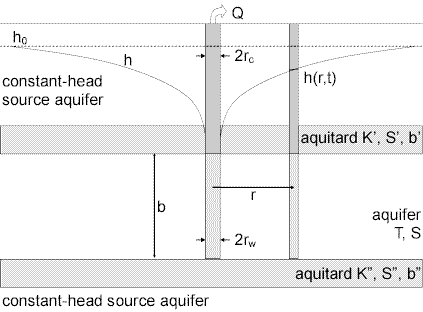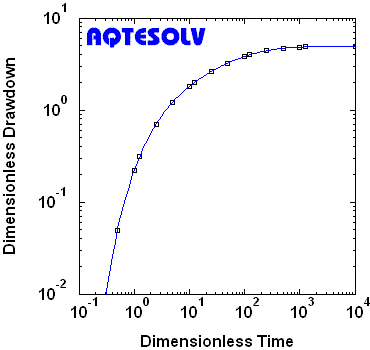Moench Solution for Leaky Confined Aquifers

Moench (1985) derived a mathematical solution that is useful for determining the hydraulic properties (transmissivity and storage coefficient of aquifer; vertical hydraulic conductivity and storage coefficient of compressible aquitards) of leaky confined aquifers. Analysis involves matching the solution to drawdown data collected during a pumping test. The Moench solution accounts for wellbore storage and wellbore skin.
When you choose a solution, AQTESOLV provides three configurations for simulating a leaky confined aquifer with aquitard storage using the Moench (1985) solution.
- Case 1 assumes constant-head source aquifers supply leakage across overlying and underlying aquitards.
- Case 2 replaces both constant-head boundaries in Case 1 with no-flow boundaries.
- Case 3 replaces the underlying constant-head boundary in Case 1 with a no-flow boundary.
You are not restricted to constant-rate tests with the Moench solution. AQTESOLV incorporates the principle of superposition in time to simulate variable-rate and recovery tests with this method.
Wellbore storage has a distinct signature in the early-time response of a pumped well. Use the radial flow and derivative-time plots to detect the wellbore storage effect.
Assumptions
- aquifer has infinite areal extent
- aquifer is homogeneous, isotropic and of uniform thickness
- aquifer potentiometric surface is initially horizontal
- control well is fully penetrating
- flow to control well is horizontal
- aquifer is leaky confined
- flow is unsteady
- water is released instantaneously from storage with decline of hydraulic head
- aquitards have infinite areal extent, uniform vertical hydraulic conductivity and storage coefficient, and uniform thickness
- aquitards are overlain or underlain by an infinite constant-head plane source
- flow in the aquitards is vertical
Equations
Moench (1985) derived an analytical solution for predicting water-level displacement in response to pumping in a leaky confined aquifer assuming fully penetrating wells, wellbore storage and wellbore skin.
The Laplace transform solution for dimensionless drawdown in the pumped well is as follows:
The following equation is the Laplace transform solution for dimensionless drawdown in an observation well:
where
- is thickness of first aquitard [L]
- is thickness of second aquitard [L]
- is head in aquifer [L]
- is static head in aquifer [L]
- is vertical hydraulic conductivity of first aquitard [L/T]
- is vertical hydraulic conductivity of second aquitard [L/T]
- is modified Bessel function of second kind, order i
- is Laplace transform variable
- is pumping rate [L³/T]
- is radial distance from pumping well to observation well [L]
- is casing radius [L]
- is well radius [L]
- is drawdown [L]
- is storativity [dimensionless]
- is storativity of first aquitard [dimensionless]
- is storativity of second aquitard [dimensionless]
- is wellbore skin factor [dimensionless]
- is elapsed time since start of pumping [T]
- is transmissivity [L²/T]
In the Laplace transform solution, is limited to positive values; however, using the effective well radius concept, we also may simulate a negative skin (Hurst, Clark and Brauer 1969).
If you enter a radius for downhole equipment, AQTESOLV uses the effective casing radius instead of the nominal casing radius in the equations for this solution.
AQTESOLV reports the aquitard properties in terms of the more familiar parameters from the Hantush (1960) solution, which one can readily compute from Moench's parameters as follows:
Data Requirements
- pumping and observation well locations
- pumping rate(s)
- observation well measurements (time and displacement)
- casing radius and wellbore radius for pumping well(s)
- downhole equipment radius (optional)
- aquifer thickness
- aquitard thickness, and (optional)
Solution Options
- large-diameter pumping wells
- variable pumping rates
- multiple pumping wells
- multiple observation wells
- boundaries
Estimated Parameters
- (transmissivity)
- (storativity)
- (leakage parameter, first aquitard)
- (leakage parameter, first aquitard)
- (leakage parameter, second aquitard)
- (leakage parameter, second aquitard)
- (wellbore skin factor)
- (well radius)
- (casing radius)
The Report view shows aquitard properties ( and ; and ) computed from the leakage parameters ( and ).
Curve Matching Tips
- Use radial flow plots to help diagnose wellbore storage.
- Use the Cooper and Jacob (1946) solution to obtain preliminary estimates of aquifer properties.
- Match early-time data affected by wellbore storage by adjusting with parameter tweaking.
- If you estimate for the test well, the estimated value replaces the nominal casing radius and AQTESOLV still performs the correction for downhole equipment.
- Choose Match>Visual to perform visual curve matching using the procedure for type curve solutions.
- Use active type curves for more effective visual matching with variable-rate pumping tests.
- Select values of and from the Family and Curve drop-down lists on the toolbar.
- Use parameter tweaking to perform visual curve matching and sensitivity analysis.
- Perform visual curve matching prior to automatic estimation to obtain reasonable starting values for the aquifer properties.
Benchmarks


References
Moench, A.F., 1985. Transient flow to a large-diameter well in an aquifer with storative semiconfining layers, Water Resources Research, vol. 21, no. 8, pp. 1121-1131.